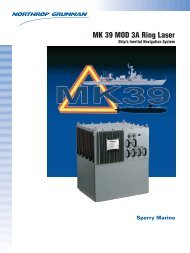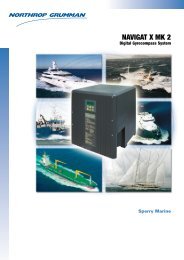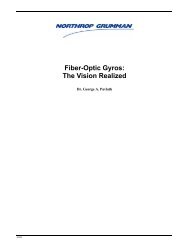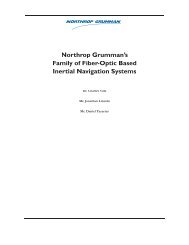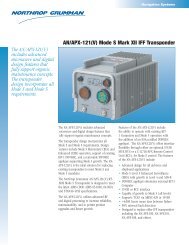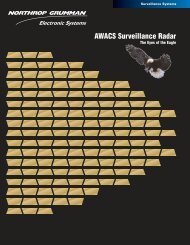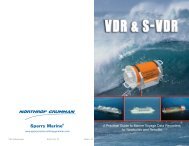Next Generation Rotorcraft ASE Systems Reserved for Newer ...
Next Generation Rotorcraft ASE Systems Reserved for Newer ...
Next Generation Rotorcraft ASE Systems Reserved for Newer ...
Create successful ePaper yourself
Turn your PDF publications into a flip-book with our unique Google optimized e-Paper software.
we’ve been in the process of upgrading nearly all<br />
fielded AAR-47 systems to the B(V)2 configuration.”<br />
RF WARNING AND THE APR-39<br />
Of all the <strong>ASE</strong> systems in service, the Northrop<br />
Grumman AN/APR-39 RWR, in its many versions,<br />
has to be the most widely installed across the DOD<br />
rotary-wing fleet, and the longest-lived. To date,<br />
over 6,000 APR-39 systems have been installed on<br />
both US and international rotorcraft plat<strong>for</strong>ms including<br />
the AH-1W/Z, UH-1N/Y, MV-22B, UH-60,<br />
OH-58D, CH-46/47/53, and AH-64A/D. Although,<br />
as observed by Overstreet, in recent conflicts such<br />
as Iraq and Afghanistan, RF threats have not proven<br />
as significant as IR and small arms fire <strong>for</strong> helicopter<br />
plat<strong>for</strong>ms, “who knows what the future will<br />
bring.”<br />
Already, the Libyan conflict has highlighted this<br />
point, but perhaps of even greater significance to<br />
the importance of the APR-39, is the role it plays on<br />
many helicopter plat<strong>for</strong>ms in also integrating and<br />
displaying warning data from other <strong>ASE</strong> sensors<br />
and systems. Integrated with both laser and missile<br />
warning systems, the newer versions of the APR-<br />
39 are increasingly serving as the overall controller<br />
<strong>for</strong> a helicopter’s <strong>ASE</strong> suite.<br />
Jeff Palombo, Northrop Grumman VP and General<br />
Manager, Land and Self Protection <strong>Systems</strong><br />
Division (Rolling Meadows, IL), says this is one of<br />
the larger next-capability functions <strong>for</strong> the AN/ APR-<br />
39. Working through the company’s <strong>Rotorcraft</strong> Avionics<br />
Innovation Laboratory (RAIL), Palombo says<br />
Northrop Grumman has been continually working<br />
to utilize and improve the APR- 39’s capabilities as<br />
an integrated <strong>ASE</strong> suite controller. “We’ve already<br />
demonstrated the ability to utilize all the targeted<br />
analog hardware on existing plat<strong>for</strong>ms, piping their<br />
in<strong>for</strong>mation into a same-<strong>for</strong>m-factor APR-39 where<br />
it is fused with the data from other sensors to provide<br />
an unambiguous, single set of threat in<strong>for</strong>mation<br />
to the pilot.” In 2010, the Army awarded<br />
Northrop Grumman a $450M IDIQ contract to upgrade<br />
770 APR-39s to the new configuration.In ad-<br />
dition, the Naval Air <strong>Systems</strong> Command announced<br />
last March that it intends to award a new sole<br />
source contract to Northrop Grumman to upgrade<br />
the APR-39 to a new AN/APR-39D(V)2 configuration.<br />
As described by Overstreet, “It’s essentially an<br />
ECP to the current system that corrects some current<br />
deficiencies and provides greater capability,<br />
but meets the same size and weight requirements<br />
of the current system.” As part of the upgrade, the<br />
39D(V2) will incorporate a new digital receiver to<br />
handle environments that include greater threat<br />
densities as well as more commercial and civilian<br />
emitters that must be sorted from the threats. “It’s<br />
one of the first <strong>for</strong>ays into digital receivers in a small<br />
<strong>for</strong>m factor <strong>for</strong> the helicopter community,” says<br />
Overstreet. “We’re leveraging our current APR-39<br />
production requirements <strong>for</strong> new helicopters and<br />
new MV-22s to upgrade to digital.” The MV-22 is<br />
the lead plat<strong>for</strong>m to receivethe upgrade.<br />
Although the Navy and Marines don’t currently<br />
have a jamming requirement <strong>for</strong> their rotary-wing<br />
aircraft, the size and<br />
weight savings offered<br />
by the digital receiver<br />
design raises the possibility<br />
of an electronic<br />
attack capability being<br />
incorporated into the<br />
APR-39D(V2) configuration.<br />
In fact, the Army<br />
has expressed interest<br />
in just that. Says Leapheart,<br />
“This is a great<br />
example of how the<br />
Services can work together.<br />
We’re watching<br />
the Navy’s ef<strong>for</strong>t very<br />
closely and hope to be able to get funding in the<br />
2014-18 timeframe to follow in the same path, both<br />
in terms of the digital RWR as well as having the<br />
potential to expand it into a jammer.”<br />
THE JOINT AND ALLIED THREAT AWARE-<br />
NESS SYSTEM (JATAS)<br />
When the Navy conceived its Joint and Allied<br />
Threat Awareness System (JATAS) program<br />
several years ago, it planned to replace most of<br />
its AAR-47 RWRs, (as well as all of its AAR-57s<br />
and Northrop Grumman AAR-54s), with the nextgeneration<br />
system that could per<strong>for</strong>m missile warning,<br />
laser warning and HFI. The Navy expected<br />
that fleet-wide installation of a common IR threat<br />
warning system would achieve modernization<br />
while limiting sustainment costs. However, the cost<br />
of buying and installing enough JATAS systems to<br />
cover most of the US Navy and USMC rotary-wing<br />
fleets is no longer viable in the constrained DOD<br />
budget. Overstreet now notes that “JATAS is designed<br />
<strong>for</strong> the smaller plat<strong>for</strong>ms” and says, beyond<br />
the lead MV-22B “Osprey” integration plat<strong>for</strong>m and<br />
Marine AH-1Z “Viper” and UH-1Y “Venom” helicopters,<br />
additional JATAS installations will be made on<br />
a “to-be-determined” basis. “JATAS is targeted <strong>for</strong><br />
the newer plat<strong>for</strong>ms, older plat<strong>for</strong>ms will not get JA-<br />
TAS, but those plat<strong>for</strong>ms will be phasing out,” says<br />
Overstreet.<br />
In addition, Overstreet says that, although the<br />
Navy is configuring JATAS to be compatible with<br />
Army plat<strong>for</strong>ms as well, the Army is not currently<br />
committed to acquiring it. “The Army is not part of<br />
our acquisition strategy in terms of procurement.<br />
We are funded and planned <strong>for</strong> Navy and Marine<br />
Corps plat<strong>for</strong>ms only. In the event that the Army<br />
does decide to equip their helicopters with a new<br />
MWS, however, OSD had directed that it must be<br />
JATAS.”<br />
JATAS is a two-color-IR-based system and, unlike<br />
the AAR-47, does not incorporate a UV component.<br />
Overstreet notes that “UV has challenges in<br />
false alarm rate, range and operation in high-clutter<br />
areas, making it unsuitable <strong>for</strong> use over urban areas.<br />
Though we’ve largely corrected this with the<br />
AAR-47B(V)2, it’s still an issue, and the fleet highly<br />
emphasizes low false-alarm rate.” As described by<br />
ATK’s Kasting, “the AAR-47 sensor is a single-pixel<br />
staring array that identifies only the quadrant that<br />
you are being attacked from, while the JATAS multispectral<br />
imaging IR sensor can calculate angle-ofarrival<br />
(AOA) and pinpoint the specific ground location<br />
of the threat. JATAS also provides a significant<br />
increase in HFI capability and laser detection over<br />
what the AAR-47 has today.” Kasting adds that,<br />
since JATAS was designed from the outset to be<br />
<strong>for</strong>m-fit-and-function compatible with the AAR-47,<br />
it will make integration across the fleet that much<br />
easier. “And, since both the hardware and software<br />
architecture is completely open, it will also be easier<br />
to integrate with other future capabilities over<br />
time.”<br />
Overstreet agrees that open architectures are<br />
key to higher levels of integration. “As new aircraft<br />
like the CH-53K, the new mission computer <strong>for</strong> the<br />
MV-22, and the open-architecture CIRCM system<br />
come along, this will enable us to do true plug and<br />
play. We’ll be able to integrate many more systems<br />
than we can now with the legacy systems. This is<br />
where the ‘glass cockpit’ display will really come<br />
into play.”<br />
JATAS interfaces with the existing AN/ALE-47<br />
Countermeasures Dispensing System (CMDS) as<br />
well as the Department of the Navy (DoN) Large<br />
Aircraft Infrared Countermeasures (LAIRCM) system,<br />
and CIRCM. Though the system is designed<br />
to be controlled by the host plat<strong>for</strong>m’s mission computer<br />
and multifunction displays, in some cases,<br />
control and indication <strong>for</strong> the JATAS will still be<br />
through the AN/APR-39.<br />
According to Overstreet, “The most basic integration<br />
may use the existing APR-39 as a bus<br />
controller and display head, but it’s a much more<br />
advanced integration as we get away from the<br />
APR-39 to mission computers and cockpit displays,<br />
as with the MV-22 integration. Future integration<br />
may tie JATAS to helmet displays like those in the<br />
AH-1Z attack helicopter.”<br />
A critical design review <strong>for</strong> JATAS is planned<br />
<strong>for</strong> May of this year, and the First EMD model hardware<br />
is scheduled to be delivered at the end of<br />
December <strong>for</strong> integration on the MV-22B, at which<br />
time it will also have an official military nomenclature.<br />
First flight tests are planned <strong>for</strong> March of<br />
2013, Low-rate initial production (LRIP) deliveries<br />
are scheduled <strong>for</strong> early 2015, and initial operational<br />
capability (IOC) is planned <strong>for</strong> later that year.<br />
ACTIVE COUNTERMEASURES: LAIRCM<br />
In general, the US military currently has four<br />
active Directed IR Countermeasure (DIRCM) programs<br />
at some stage of implementation. For large<br />
rotorcraft, these include the Air Force’s (AAQ-<br />
24(V) Large Aircraft IR Countermeasure (LAIRCM)<br />
system, and the follow-on Department of the Navy<br />
(DoN) LAIRCM ef<strong>for</strong>t. Since both of these systems<br />
are produced by Northrop Grumman, they tend to<br />
incorporate similar technology and sensor configurations.<br />
Says Northrop Grumman’s Palombo, “Essentially<br />
what we provide with LAIRCM and DoN LAIR-<br />
CM is an open architecture system that enables our<br />
customers to work with us to select the best capability<br />
<strong>for</strong> their specific application. For example, the<br />
USMC customer has a five-sensor solution on their<br />
CH-53s that are in a podded configuration, allowing<br />
the system to be transferred from aircraft to aircraft<br />
to save costs.” To date, LAIRCM has been integrated<br />
with five different missile warning systems, as<br />
well multiple jam heads, cockpit displays and other<br />
plat<strong>for</strong>m-specific subsystems.<br />
Together, the Navy and Marine Corps are equipping<br />
156 CH-53D, CH-53E and CH-46E transport<br />
helicopters with DoN LAIRCM systems. The system<br />
includes the Northrop Grumman “Viper” laser,<br />
as well as the Guardian Laser Transmitter Assembly<br />
and the AAR-54 missile warning system. The<br />
Navy has contracted with Northrop Grumman to<br />
begin replacing the DoN LAIRCM system’s UV missile<br />
warning sensors with two-color IR Advanced<br />
Threat Warning (ATW) sensors. Along the lines of<br />
JATAS multifunctionality, ATW sensors will enable<br />
the DoN LAIRCM system to per<strong>for</strong>m missile warning,<br />
laser warning and HFI, as well as potentially<br />
provide video <strong>for</strong> situational awareness.<br />
According to Palombo, “Through the ATW<br />
multi-function sensor, we’ve been able to continually<br />
physically shrink the hardware while providing<br />
additional capability in the same <strong>for</strong>m factor. This<br />
approach allows you to remove other plat<strong>for</strong>m sensors<br />
and their associated processors, potentially<br />
saving 40-50 lbs on a helicopter plat<strong>for</strong>m.” Says<br />
Overstreet, “The in<strong>for</strong>mation is much more precise<br />
with obviously lower false alarm rates. It’s probably<br />
the most capable missile warning system out there<br />
until JATAS comes on line together with a very capable<br />
IR jammer.” A critical design review (CDR)<br />
of the ATW sensor has been completed, and it will<br />
go into flight test later this year. Overstreet says<br />
it should be made available to the fleet sometime<br />
next year.<br />
Northrop Grumman is also now in production<br />
on a new missile warning system design <strong>for</strong> the US<br />
Air Force’s LAIRCM program. The USAF awarded<br />
the company a $79 million contract last year <strong>for</strong> the<br />
“NexGen MWS,” which will be installed on Air Force<br />
Special Operations Command CV-22s, as well as<br />
C-17, C-130 and C-5 aircraft.<br />
ATIRCM<br />
In the meantime, <strong>for</strong> the Army, the BAE <strong>Systems</strong>’<br />
AN/ALQ-212(V) Advanced Threat IR Countermeasures<br />
System (ATIRCM) continues to play<br />
a role <strong>for</strong> that Service’s larger rotorcraft plat<strong>for</strong>ms.<br />
In September of last year, the Army increased the<br />
number of CH-47s that will be fitted with the ALQ-<br />
212 ATIRCM from 83 helicopters to 120. As described<br />
by Leapheart, “ATIRCM has enjoyed higher<br />
reliability than anyone thought it would, with reliability<br />
numbers in theater three-to-four times projections.<br />
Because of this, we’ve actually been able<br />
to pull spare LRUs off the shelf and assemble end<br />
items to equip some of the CH-47s in advance of<br />
the production units. We don’t want any CH-47s in<br />
theater flying without that protection aboard.” Leapheart,<br />
expects this will be the final procurement <strong>for</strong><br />
ATIRCM, so as units rotate home, the Army will rely<br />
on a plan to regularly transfer its existing inventory<br />
of ATIRCM systems to deploying aircraft.<br />
CIRCM<br />
The big EW news of the year thus far is the<br />
Army’s awarding of two Technology Development<br />
(TD) contracts <strong>for</strong> the Common Infrared Countermeasures<br />
(CIRCM) system. Northrop Grumman<br />
($31.4 million) and BAE <strong>Systems</strong> ($38 million)<br />
received the awards on January 31 to develop<br />
the next-generation countermeasures system <strong>for</strong><br />
rotary-wing, tilt-rotor, and small fixed wing aircraft<br />
across the DOD. The 21-month TD phase contracts<br />
include both cost plus fixed-fee (CPFF) and firmfixed<br />
price (FFP) elements and will utilize competitive<br />
prototyping.<br />
The open-architecture, lightweight (85-lb max.),<br />
laser-based countermeasure system is intended<br />
to protect aircraft from all types of IR-guided missiles,<br />
especially man-portable air defense systems<br />
(MANPADS) such as the SA-7, -14, -16, -18 and<br />
-24. An alternative to the larger and heavier LAIR-<br />
CM and ATIRCM systems, the baseline CIRCM will<br />
be fully integrated with an <strong>ASE</strong> suite that includes<br />
passive missile warning, an improved countermeasures<br />
dispenser, and advanced expendables.<br />
Ultimately, CIRCM may have additional capabilities<br />
as well, such as “dazzling” to counter small<br />
arms fire, and laser-based inter-helicopter communication.<br />
As explained by Colonel Leapheart, the<br />
actual capabilities development document (CDD)<br />
<strong>for</strong> CIRCM won’t be due until the follow-on Milestone<br />
B, Engineering Manufacturing Development<br />
(EMD) phase. “In the TD phase we’ll be looking at<br />
where the technology is, the designs being brought<br />
<strong>for</strong>ward by the vendors, as well as opportunities to<br />
provide some of these other capabilities. They’re<br />
not part of the current requirement, but we anticipate<br />
that, as we go through the TD phase, we’ll<br />
do some exploration on those capabilities and see<br />
how feasible it is at that time to make those a requirement<br />
<strong>for</strong> CIRCM – maybe not as an initial capability,<br />
but as part of evolutionary growth.”<br />
Says Northrop Grumman’s Jeff Palombo, “CIR-<br />
CM has the opportunity to do a lot of things, but it all<br />
depends on what the customer asks <strong>for</strong>. For us, the<br />
linchpin is our open-system architecture that allows<br />
<strong>for</strong> the integration of systems and equipment, not<br />
only from Northrop Grumman, but others as well.<br />
For example, Daylight Solutions (San Diego, CA)<br />
is providing the laser, and Selex Galileo (Lincoln,<br />
UK) is providing the jam head <strong>for</strong> our CIRCM system.<br />
So, if the Government asks us to put ‘different<br />
light’ through the CIRCM jam head – i.e., a potential<br />
dazzle capability, or to provide <strong>for</strong> laser communication<br />
– we can enable our system to do this.”<br />
As reported in the January 2012 JED, the Army<br />
has said it wants to equip 1,075 Apache, Black<br />
Hawk, upgraded Kiowa Warrior and other helicopters<br />
with the CIRCM system, while the Navy and<br />
Marine Corps are looking <strong>for</strong> a system suitable <strong>for</strong><br />
their SH-60, AH-1Z, and other rotorcraft plat<strong>for</strong>ms.<br />
However, with a first-unit- equipped date now<br />
pushed out to the first quarter of FY19, the actual<br />
mix and number of plat<strong>for</strong>ms receiving CIRCM<br />
could vary dramatically.<br />
INTEGRATED <strong>ASE</strong> – THE SHAPE OF THE<br />
FUTURE<br />
As improvements to existing systems and the<br />
development and deployment of the next generation<br />
of <strong>ASE</strong> equipment continues, the Services and<br />
industry are already looking ahead to the requirements,<br />
design and development of the next generation<br />
capability. Leapheart says the Army sees<br />
this as a two-phase ef<strong>for</strong>t. “The difference between<br />
the two really comes down to the generation of aircraft<br />
you’re talking about – what you can do on the<br />
current generation of aircraft and what you can do<br />
on the next, i.e., Joint Multi-Role (JMR) rotorcraft,<br />
Joint Vertical Heavy Lift and other new development<br />
ef<strong>for</strong>ts like the Air Force-led Joint Future Theater<br />
Lift (JFTL) ef<strong>for</strong>t.”<br />
In September of last year, the Army reorganized<br />
its PM-<strong>ASE</strong> project office toward this objective,<br />
including the creation of an Assistant Product<br />
Reprint Courtesy of Journal of Electronic Defense (March 2012) Reprint Courtesy of Journal of Electronic Defense (March 2012)



